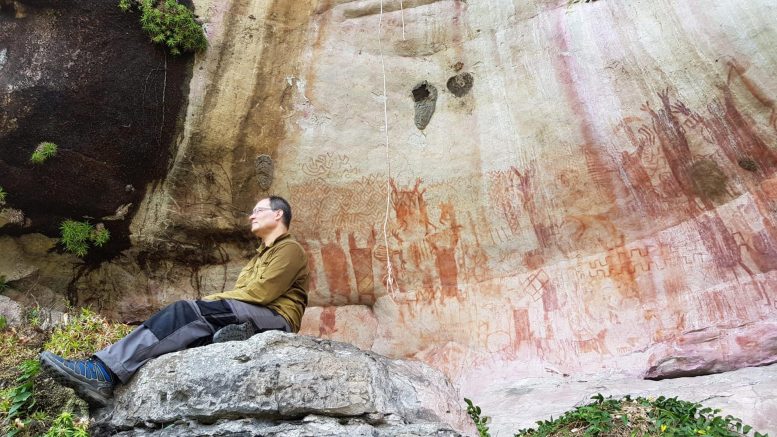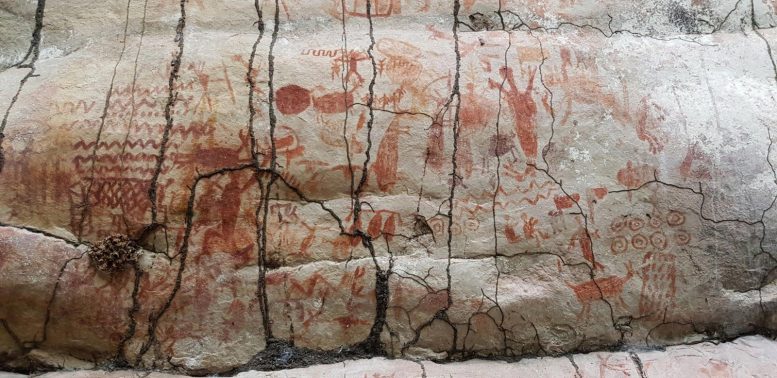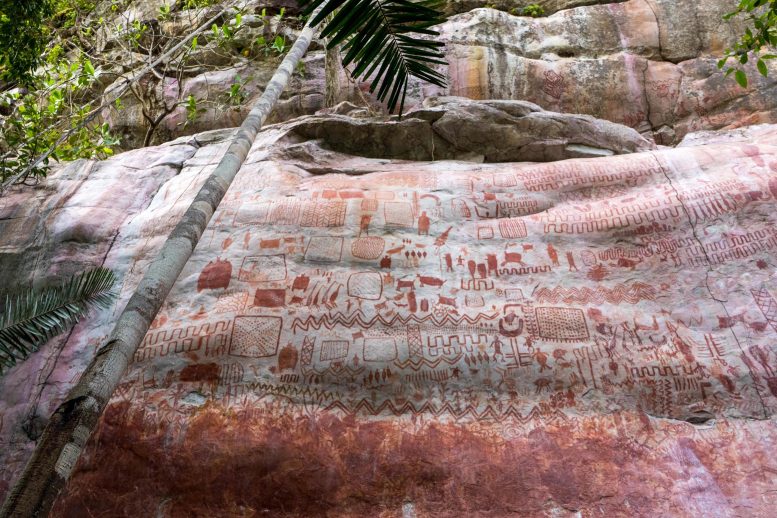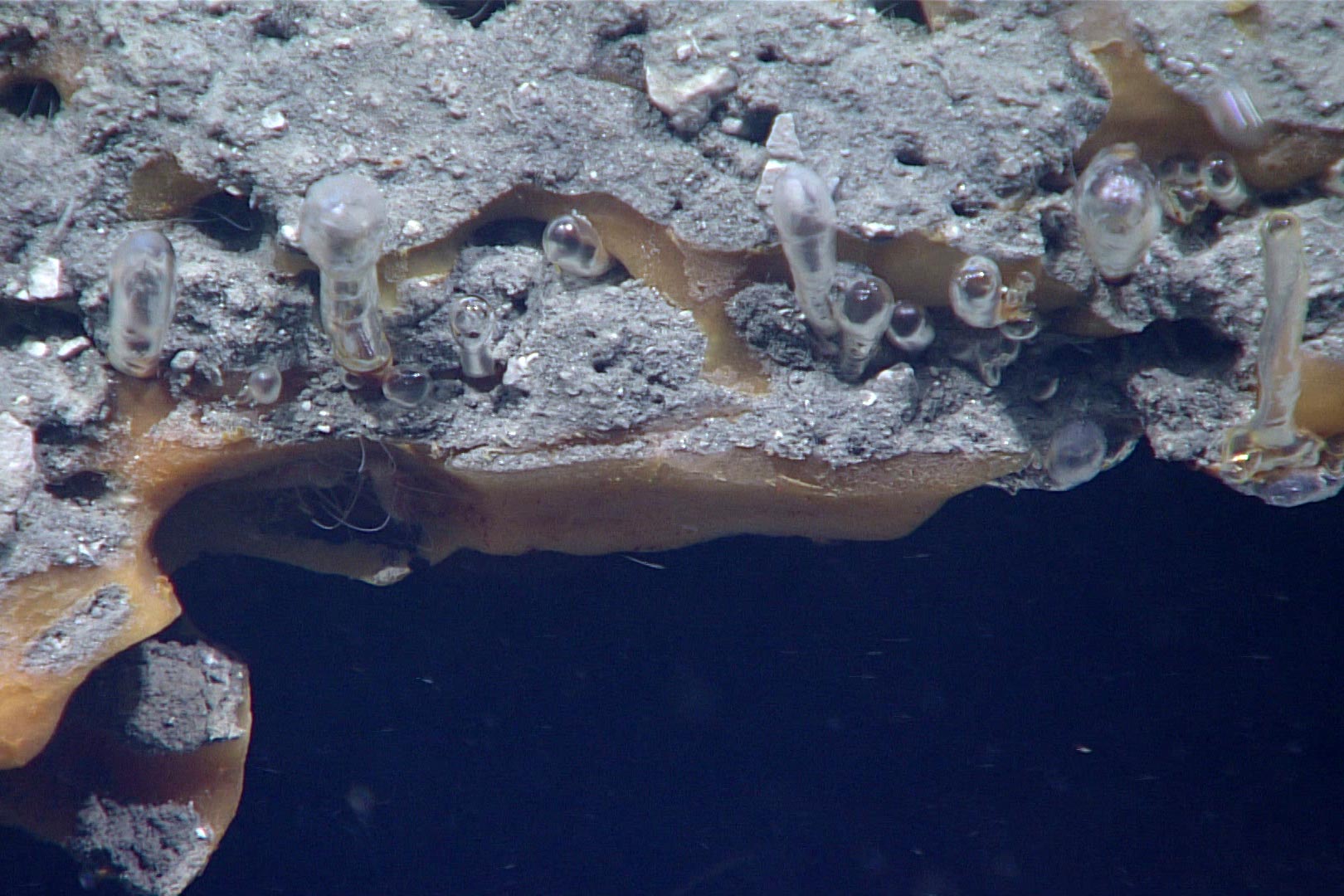Last year, the team discovered the historic work of art, now known as the “Sistine Chapel of the Ancients”, on cliffs in Colombia’s Chiribiquete National Park. Photo credit: Wild Blue Media
The rock art of the Amazon, newly discovered by researchers, provides further evidence that the earliest inhabitants of the rainforest lived next to giant Ice Age animals, which have now become extinct.
The thousands of images are among the oldest depictions of people interacting with the giant creatures, including mastodons. Usually the only clues about their appearance are skeletal remains.
This is one of the largest collections of rock art in South America. The recorded drawings, which were probably first made 12,600 and 11,800 years ago, are located on three rock shelters on hills in the Colombian Amazon. The paintings, identified through landscape surveys, also show geometric shapes, human figures and handprints, as well as hunting scenes and people interacting with plants, trees and savannah animals. The bright red images were produced over hundreds or possibly thousands of years. Some are so high and inaccessible that special ladders made from forest resources would have been needed and would not be visible to anyone visiting the rock shelter.

Professor José Iriarte. Photo credit: University of Exeter
There are drawings of deer, tapirs, alligators, bats, monkeys, turtles, snakes and porcupines as well as an apparently Ice Age megafauna. These now-extinct animals are depicted in rock art in central Brazil, but experts believe these drawings are more realistic. There are depictions of creatures that resemble a giant sloth, mastodon, camelid, horse, and three-toed ungulate with trunks. These native animals all became extinct, likely due to a combination of climate change, habitat loss, and human hunting.
The excavations in the deep ground around the shelters have revealed one of the earliest certain dates for the occupation of the Colombian Amazon and evidence of the diet of the people of the time, as well as the remains of small tools and scraped ocher that were used to extract pigments To take pictures.
Communities living in the area at the time the drawings were made were hunter-gatherers who fished in the nearby river. Bones and plant debris found during the excavations indicate that they ate palm and tree fruits, piranha, alligators, snakes, frogs, rodents such as paca and capybara, and armadillos.

Photo credit: Professor José Iriarte
The discovery was made by researchers from the ERC LASTJOURNEY project, who are working to find out when people settled in Amazonia and what impact their agriculture and hunting had on the biodiversity of the area. It’s included in a new Channel 4 (UK) series. Jungle Mystery: Lost Kingdoms of the Amazon. The results are also described in an article in the journal Quaternary International.
The paintings on specially prepared rock faces of the Serranía La Lindosa on the northern edge of the Colombian Amazon are further evidence of the impact of early human communities on the biodiversity of the Amazon and their adaptation to climate change. By the time the drawings were made, temperatures rose and began to transform the area from a mosaic landscape of mottled savannahs, thorny scrub, gallery forests and tropical forests with montane elements to the broad-leaved tropical Amazon forest of today.

Photo credit: Marie-Claire Thomas / Wild Blue Media
The rock shelters are a long way from modern settlements and trails, but were known to some local communities who helped researchers explore.
The research was made possible after the 2016 peace treaty between the FARC and the Colombian government.
The research was carried out by Gaspar Morcote-Ríos from the Universidad Nacional de Colombia, Francisco Javier Aceituno from the Universidad de Antioquia, José Iriarte and Mark Robinson from the University of Exeter, and Jeison L. Chaparro-Cárdenas from the Universidad Nacional de Colombia.
Dr. Robinson said, “These are truly incredible images that were produced by the earliest humans in the western Amazon. They moved to the region at a time of extreme climate change, which led to changes in the vegetation and the composition of the forest. The Amazon was still turning into the tropical forest we see today.
“The pictures give a lively and exciting insight into the life of these communities. It is incredible for us today to believe that they lived among and hunted giant herbivores, some of which were the size of a small car. ”
The rock shelters are exposed to the elements, meaning other paintings discovered by experts in the Amazon have been damaged and the images are unclear. Communities peeled or fire peeled the stone to create smooth surfaces for their art.
These new discoveries are in shelters that are better protected from overhanging rocks or wind and rain blowing in a different direction.
Professor Iriarte said, “These rock art is spectacular evidence of how people reconstructed the land and how they hunted, tilled and fished. It’s likely that art was a strong part of culture and a way for people to connect socially. The pictures show how people would have lived among giant, now extinct animals that they hunted. ”
Experts carried out the excavations in 2017 and 2018. The largest collection of paintings was found at Cerro Azul, where there are a total of 12 panels and thousands of individual pictograms depicting people, animals, plants, handprints and geometric shapes. The paintings in Cerro Montoya and Limoncillos had faded.
The discovery appears in new series on the Amazon, which will appear on Channel 4 in the UK the first week of December – Jungle Mystery: Lost Kingdoms of the Amazon. The series, hosted by Ella Al Shamahi, explores lost civilizations and reveals hidden ancient settlements and rock carvings never before seen.



